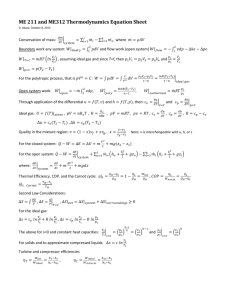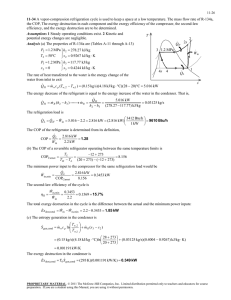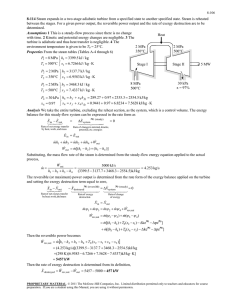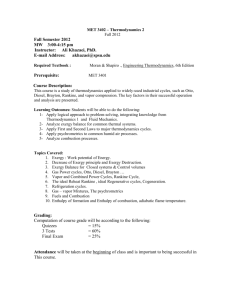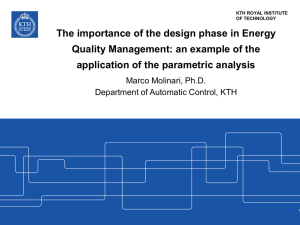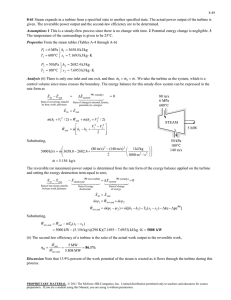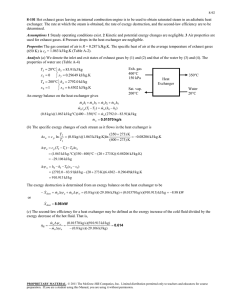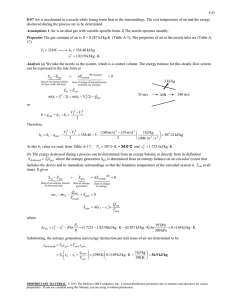Research Journal of Applied Sciences, Engineering and Technology 5(15): 3876-3882,... ISSN: 2040-7459; e-ISSN: 2040-7467
advertisement
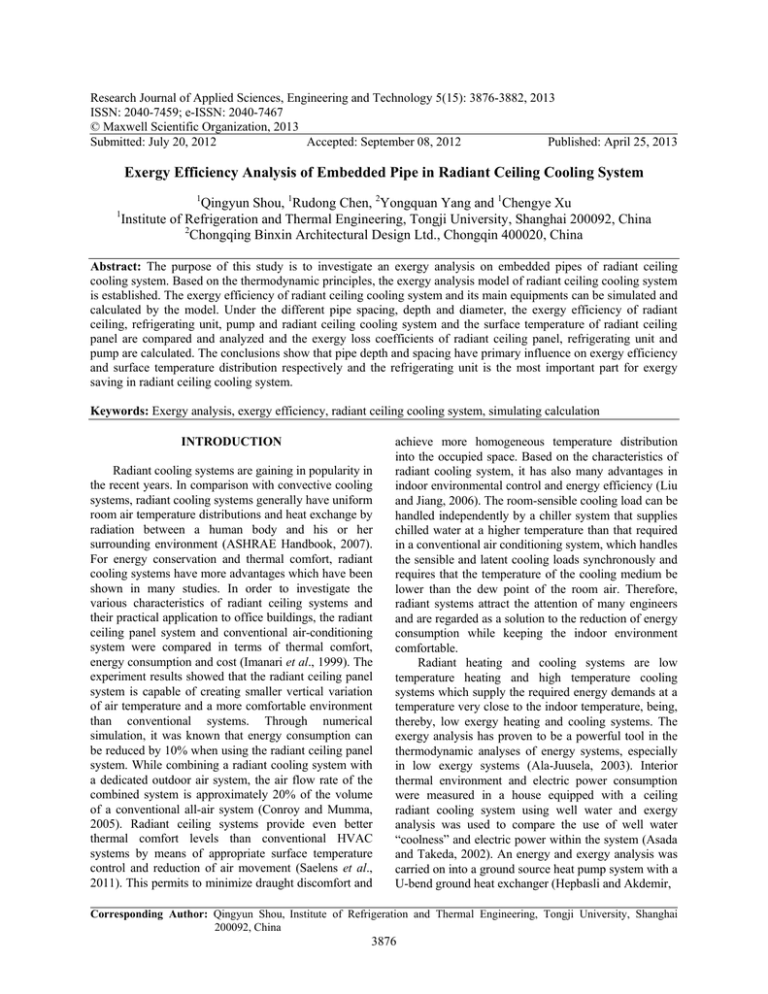
Research Journal of Applied Sciences, Engineering and Technology 5(15): 3876-3882, 2013 ISSN: 2040-7459; e-ISSN: 2040-7467 © Maxwell Scientific Organization, 2013 Submitted: July 20, 2012 Accepted: September 08, 2012 Published: April 25, 2013 Exergy Efficiency Analysis of Embedded Pipe in Radiant Ceiling Cooling System 1 Qingyun Shou, 1Rudong Chen, 2Yongquan Yang and 1Chengye Xu Institute of Refrigeration and Thermal Engineering, Tongji University, Shanghai 200092, China 2 Chongqing Binxin Architectural Design Ltd., Chongqin 400020, China 1 Abstract: The purpose of this study is to investigate an exergy analysis on embedded pipes of radiant ceiling cooling system. Based on the thermodynamic principles, the exergy analysis model of radiant ceiling cooling system is established. The exergy efficiency of radiant ceiling cooling system and its main equipments can be simulated and calculated by the model. Under the different pipe spacing, depth and diameter, the exergy efficiency of radiant ceiling, refrigerating unit, pump and radiant ceiling cooling system and the surface temperature of radiant ceiling panel are compared and analyzed and the exergy loss coefficients of radiant ceiling panel, refrigerating unit and pump are calculated. The conclusions show that pipe depth and spacing have primary influence on exergy efficiency and surface temperature distribution respectively and the refrigerating unit is the most important part for exergy saving in radiant ceiling cooling system. Keywords: Exergy analysis, exergy efficiency, radiant ceiling cooling system, simulating calculation INTRODUCTION Radiant cooling systems are gaining in popularity in the recent years. In comparison with convective cooling systems, radiant cooling systems generally have uniform room air temperature distributions and heat exchange by radiation between a human body and his or her surrounding environment (ASHRAE Handbook, 2007). For energy conservation and thermal comfort, radiant cooling systems have more advantages which have been shown in many studies. In order to investigate the various characteristics of radiant ceiling systems and their practical application to office buildings, the radiant ceiling panel system and conventional air-conditioning system were compared in terms of thermal comfort, energy consumption and cost (Imanari et al., 1999). The experiment results showed that the radiant ceiling panel system is capable of creating smaller vertical variation of air temperature and a more comfortable environment than conventional systems. Through numerical simulation, it was known that energy consumption can be reduced by 10% when using the radiant ceiling panel system. While combining a radiant cooling system with a dedicated outdoor air system, the air flow rate of the combined system is approximately 20% of the volume of a conventional all-air system (Conroy and Mumma, 2005). Radiant ceiling systems provide even better thermal comfort levels than conventional HVAC systems by means of appropriate surface temperature control and reduction of air movement (Saelens et al., 2011). This permits to minimize draught discomfort and achieve more homogeneous temperature distribution into the occupied space. Based on the characteristics of radiant cooling system, it has also many advantages in indoor environmental control and energy efficiency (Liu and Jiang, 2006). The room-sensible cooling load can be handled independently by a chiller system that supplies chilled water at a higher temperature than that required in a conventional air conditioning system, which handles the sensible and latent cooling loads synchronously and requires that the temperature of the cooling medium be lower than the dew point of the room air. Therefore, radiant systems attract the attention of many engineers and are regarded as a solution to the reduction of energy consumption while keeping the indoor environment comfortable. Radiant heating and cooling systems are low temperature heating and high temperature cooling systems which supply the required energy demands at a temperature very close to the indoor temperature, being, thereby, low exergy heating and cooling systems. The exergy analysis has proven to be a powerful tool in the thermodynamic analyses of energy systems, especially in low exergy systems (Ala-Juusela, 2003). Interior thermal environment and electric power consumption were measured in a house equipped with a ceiling radiant cooling system using well water and exergy analysis was used to compare the use of well water “coolness” and electric power within the system (Asada and Takeda, 2002). An energy and exergy analysis was carried on into a ground source heat pump system with a U-bend ground heat exchanger (Hepbasli and Akdemir, Corresponding Author: Qingyun Shou, Institute of Refrigeration and Thermal Engineering, Tongji University, Shanghai 200092, China 3876 Res. J. Appl. Sci. Eng. Technol., 5(15): 3876-3882, 2013 2004). The experiment results indicated that the highest irreversibility occurred in the motor-compressor subassembly and the evaporator had the lowest irreversibility on the basis of the heat pump cycle. Using actual system data, an assessment of the performance, energy efficiency, exergy efficiency and exergy destructions in the geothermal district heating system was conducted (Ozgener et al., 2005). The results showed that energy and exergy efficiencies of the overall system were determined to be 41.9 and 46%, respectively. Two local Turkish geothermal district heating systems were evaluated through exergy analysis (Ozgener et al., 2007). The exergy destructions in these systems were quantified and illustrated using exergy flow diagrams. The exergy destructions particularly occurred due to losses in pump, heat exchangers, pipelines and the reinjection of thermal water. Exergy efficiencies of the 2 systems were investigated for the system performance analysis and improvement and were determined to be 42.89 and 59.58%, respectively. As described above, many characteristics of radiant cooling systems have been studied by a number of researchers, including energy conservation, thermal comfort and integrating with convection system. However, the researches on the pipe layout of radiant cooling system are relatively few in numbers. The design of the pipe layout is very important for the energy performance and thermal comfort of radiant cooling system. Besides this, the main objective of this study is to investigate an exergy analysis on embedded pipes in radiant ceiling cooling system. In this regard, 1st, the exergy analysis model of radiant ceiling cooling system is established. Under the different pipe spacing, depth and diameter, the exergy efficiency of radiant ceiling, refrigerating unit, pump and radiant ceiling cooling system and the surface temperature of radiant ceiling panel are then simulated and compared. Finally, the exergy loss coefficients are calculated. low temperature heat source during evaporation is effective exergy; heat exergy E x,qk input from system to high temperature heat source during condensing is external exergy loss; ∑E xl,r is the combination of internal exergy loss in compressor, evaporator, condenser and throttle valves. Besides, cold and heat exergy can respectively express as: T0 = Ex,q0 Q0 T0 ' − 1 T0 Tk ' E = Qk 1 − x,qk (2) (3) From which, the exergy efficiency of refrigerating unit can be defined as: ηex,r = Ex,q0 / Wr (4) Radiant ceiling: There are many ways to distribute radiant ceiling pipes, involving double-U type as the object studied in this study. Since high and low temperature pipes are alternate from the view of whichever cross-section passing the center of the panel, characteristic of even temperature of the panel can be derived from the formation of even effect and the existence of “zero heat surface” effect. It can be divided into three heat transfer processes between cold water in the panel pipes and the ambient environment (Fu, et al., 2000). The 1st one is convection heat transfer between cold water in pipes and the pipe walls; the 2nd one is conduction heat transfer between the pipe walls and the panel surface via concrete cover layer; the 3rd one is combined heat transfer of radiation and convection between the panel surface and ambient air or nearby walls. Exergy analysis of radiant ceiling is equivalent to EXERGY ANALYSIS MODEL analysis of exergy transfer in conduction process (Li, 2001). First of all, conduction differential equation and Cold source: Cold source of radiant ceiling cooling exergy transfer equation set should be established and system mostly refers to electric refrigerating units, temperature field can be solved, then other properties in composed of compressor, evaporator, condenser and the exergy transfer will be calculated. Space and time throttle valve. Exergy entering refrigerating units distribution rules of exergy can be achieved by should equal to the sum of various exergy exiting units application to practical process of basic dynamic and internal exergy loss. The exergy balance Eq. can be equation set of exergy transfer, framed with mass obtained: conservation equation, momentum conservation equation, energy conservation equation and exergy Wr = Ex,q0 + Ex,qk + Exl,r (1) balance dynamic equation obtained by using differential calculus to exergy equation in average thermodynamics. If environment temperature is to be used as in which, work consumption of compressor W r is calculating origin, heat exergy flow is solved as: exergy input; cold exergy E x,q0 output from system to 3877 ∑ Res. J. Appl. Sci. Eng. Technol., 5(15): 3876-3882, 2013 0 T0 T − 1 − eq = 1 − q = T T λ ∇T (5) Source From the perspective of exergy transfer, temperature difference △T is sufficient and necessary for heat exergy transfer, so, with regard to a certain temperature field, there is a certain heat flow intensity field, with a certain exergy flow intensity filed. Therefore, for mere conduction process, regardless of its absence of internal heat source or transient and steady status, exergy flow intensity distribution can be calculated by exergy transfer only on the requirement of its temperature distribution. Apparently, heat exergy intensity field shares the same direction as a vector field with heat flow intensity field, in which, exergy intensity on the x direction is: T 0 ln (T / T 0 ) ∆Tx T 0 ∂T eq,x = −λ 1 − = −λ 1 − T ∂x T −T0 ∆x (6) And exergy intensity on the y direction is: eq,y = −λ 1 − T 0 ln (T / T 0 ) ∆Ty = −λ 1 − T ∂y T −T0 ∆y T 0 ∂T Wr Ex,qk (7) ∑Exl,r Ex,q0 Exw0 Exp,irr Exl,p Pump Wp Exw2 Exw1 Ceiling Exl,c Ex,c Fig. 1: Exergy analysis model of radiant ceiling cooling system = ηex,c Ex,c / ( Exw2 − Exw1 ) (10) Pump: Supply exergy of the pump being W p , effective exergy output being mass flow exergy difference (E xw1 -E xw0 ) of water obtaining pressure exergy, internal exergy loss being E xp,irr , external exergy loss being leaked exergy loss E xl,dp , exergy balance equation of the pump is: Wp + Exw0 = Exw1 + Exp,irr + Exl,dp (11) From which the whole exergy intensity is: Exergy efficiency of the pump is: = eq 2 q,x e +e 2 q,y In 2-dimensional conduction process, it is complicated to solve temperature field through analytical method, let alone other analytical expression of properties in exergy transfer, even possibly leading to severe distortion in results. Instead, using derived relation expression between properties and temperature in exergy transfer, along with numerical calculation, we can reach exergy transfer calculation. After achievement of exergy flow intensity distribution on radiant ceiling panel surface, integral on area can lead to exergy flow E x,c transferred to panel surface, which is: Ex ,c = ∫ eq dA = ηex,p (8) (9) In the exergy analysis model of radiant ceiling, with cost exergy being exergy difference (E xw2 -E xw1 ) between supply water and return water in embedded pipes and benefit exergy E x,c being exergy flow transferred to ceiling panel surface, exergy efficiency of radiant ceiling is: ( Exw1 − Exw0 ) / Wp (12) Radiant ceiling cooling system: Radiant ceiling cooling system consists of radiant ceiling, cold source and pump, whose exergy analysis model is shown in Fig. 1. Adding up all the exergy balance equation of all the facility leads to: Wr + Wp + ( Exw0 − Exw2 )= Ex,q0 + Ex,qk + Ex,c + ( ∑ Exl,r + Exp,irr + Exl,p + Exl,c ) (13) and let Since E x,q0 =E xw0 -E xw2 E xl,s =∑E xl,r +E xp,irr +E xl,p +E xl,c +E x,qk , Eq. (13) can be simplified as: Wr + Wp = Ex,c + Exl,s (14) Therefore, Eq. (14) is the exergy balance equation of radiant ceiling cooling system. Referring to the principle “total exergy loss of the system is the combination of exergy loss of all the 3878 Res. J. Appl. Sci. Eng. Technol., 5(15): 3876-3882, 2013 Radiant ceiling cooling system Radiant ceiling Refrigerating unit Pump facility”, we can derive the exergy efficiency equation of the system as: 70 Ex,c Wr + Wp = 1− Exl,s Wr + Wp 50 The exergy loss coefficient of each facility is: λi = Exl,i Wr + Wp 60 (15) ηex,s/% ηex,s = 40 30 (16) 20 10 100 COMPUTER SIMULATION ANALYSIS OF EXERGY EFFICIENCY AND SURFACE TEMPERATURE 150 200 s/mm 250 300 Fig. 3: Exergy efficiency changes with pipe spacing Pipe spacing: When pipe depth h=40 mm and pipe diameter d=20 mm, exergy efficiency of each facility s = 100 s = 200 s= 250 s= 300 23 Surface temperature/ C Factors vary upon surface temperature of radiant ceiling and its distribution such as the formation of embedded pipes, pipe spacing, pipe depth and pipe diameter. Given the established exergy analysis model, using MATLAB software in this essay to simulate different pipe spacing, depth and diameter, we studied and analyzed exergy efficiency of radiant ceiling, refrigerating unit, pump and radiant ceiling cooling system and also surface temperature distribution of radiant ceiling. The simulation object is a typical room of office building in Shanghai (Fig. 2), with its size of 7×5×3 m, room designed temperature of 26 °C, relative humidity of 60%, sensible heat load of 1813 W on radiant ceiling. Embedded pipes used a pattern of double-U type, conductive coefficient of which is 1.5 W/(m·°C). o 22 21 20 19 18 17 0 50 150 200 100 Piped distance/mm 250 300 Fig. 4: Surface temperature changes with pipe spacing and radiant ceiling surface temperature distribution varying with pipe spacing are shown as Fig. 3 and 4. From Fig. 3, exergy efficiency of radiant ceiling increases with pipe spacing, s. It is because, with the increase of s and the decrease of cold water temperature in embedded pipes, the amplification of exergy difference between supply and return water as cost exergy is smaller than that of exergy flow on the radiant ceiling surface as benefit exergy caused by the decrease of pipe wall temperature, that the exergy efficiency of radiant ceiling increases proportionally with s. In the meantime, it can be observed that exergy at s as 300 mm increases with a small amplification against that at s as 250 mm, which implies that rise of exergy efficiency, is to a great extent limited even though s can be raised a lot more. Nevertheless, from Fig. 4, the property of even distribution of surface temperature on radiant ceiling gradually worsens with the increase of s. Exergy Fig. 2: A schematic representation of radiant ceiling cooling efficiency of refrigerating unit and the pump changes panel with pipe spacing to a less degree, while exergy 3879 Res. J. Appl. Sci. Eng. Technol., 5(15): 3876-3882, 2013 Radiant ceiling cooling system Radiant ceiling Refrigerating unit Pump 70 60 60 50 50 ηex,s/% ηex,s/% 70 40 40 30 30 20 20 10 10 20 30 40 h/mm 50 60 22 d = 25 d = 30 d = 35 Surface temperature/ C Surface temperature/ C 23 d = 15 15 20 25 d/mm 30 35 Fig. 7: Exergy efficiency changes with pipe diameter Fig. 5: Exergy efficiency changes with pipe depth o Radiant ceiling cooling system Radiant ceiling Refrigerating unit Pump o 21 20 19 23 h = 15 22 h = 25 h = 30 h = 35 21 20 19 18 18 17 0 17 0 50 100 150 200 Piped distance/mm 250 300 50 100 150 Piped distance/mm 200 Fig. 8: Surface temperature changes with pipe diameter Fig. 6: Surface temperature changes with pipe depth efficiency of radiant ceiling cooling system is proportional with pipe spacing due to its tendency of being influenced by radiant ceiling. 200 mm of pipe spacing is regarded proper when considering both exergy efficiency and whether the surface temperature is even or not. therefore exergy efficiency of radiant ceiling drops apparently with the increase of h. From Fig. 6, the property of even surface temperature distribution on radiant ceiling gradually deteriorates with the reduction of h. It is because of the big part of pipe temperature on surface temperature at a small h, which results in uneven temperature distribution and the enervation of heat storage capacity chosen as one of the important characteristic of concrete embedding method. Exergy efficiency of refrigerating unit and the pump changes with pipe depth at the same little degree, but exergy efficiency of radiant ceiling cooling system dwindles with the augment of depth. 40 mm of pipe depth is regarded proper when considering exergy efficiency, energy storage capacity and whether the surface temperature is even or not. Pipe depth: When pipe spacing s=200 mm and pipe diameter d=20 mm, exergy efficiency of each facility and radiant ceiling surface temperature distribution varying with pipe depth are shown as Fig. 5 and 6. From Fig. 5, exergy efficiency of radiant ceiling drops dramatically with the increase of pipe depth, h. Increasing h leads to greater conduction resistance and therefore exergy flow as benefit exergy on radiant ceiling surface gradually declines. On the other hand, Pipe diameter: When pipe spacing s = 200 mm and decreasing supply and return water temperature with pipe dept h = 40 mm, exergy efficiency of each facility and radiant ceiling surface temperature distribution increasing h leads to the increase of exergy difference varying with pipe diameter are shown in Fig. 7 and 8. between supply and return water as cost exergy and 3880 Res. J. Appl. Sci. Eng. Technol., 5(15): 3876-3882, 2013 Table 1: Exergy loss coefficient of radiant ceiling, pump and refrigerating unit in different pipe spacing (%) Pipe spacing -------------------------------------------Exergy loss coefficient 100 150 200 250 300 λc 20.8 20.6 20.4 19.7 19.6 λr 56.5 56.1 55.9 55.7 55.4 λp 3.5 3.4 3.4 3.3 3.1 Table 2: Exergy loss coefficient of radiant ceiling, pump and refrigerating unit in different pipe depth (% Pipe depth ---------------------------------------------Exergy loss coefficient 20 30 40 50 60 λc 16.4 18.4 20.3 21.6 22.5 λr 56.0 56.0 55.9 55.9 55.8 λp 3.4 3.4 3.4 3.3 3.3 Table 3: Exergy loss coefficient of radiant ceiling, pump and refrigerating unit in different pipe diameter (%) Pipe diameter -----------------------------------------------Exergy loss coefficient 15 20 25 30 35 λc 20.1 20.3 20.4 20.5 20.5 λr 55.8 55.9 56.1 56.2 56.2 λp 3.3 3.4 3.4 3.4 3.5 From Fig. 7, exergy efficiency of radiant ceiling decreases with the increases of pipe diameter, d. It is because, with the increase of d and the increase of cold water temperature in embedded pipes, the diminish of exergy flow on the radiant ceiling surface as benefit exergy is smaller than that of exergy difference between supply and return water as cost exergy caused by the increase of pipe temperature, that exergy efficiency of radiant ceiling decreases with the increase of d. From Fig. 8, the property of even surface temperature distribution on radiant ceiling gradually deteriorates with the reduction of d, but appears to be little distinction among different pipe diameters. Exergy efficiency of refrigerating unit and the pump changes with pipe diameter at the same little degree as well, but exergy efficiency of radiant ceiling cooling system dwindled with the augment of pipe diameter. 20 mm of pipe diameter is regarded proper when considering both exergy efficiency and whether the surface temperature is even or not. When exergy efficiency of each facility of radiant ceiling cooling system is calculated, we are acknowledged with exergy loss coefficient of radiant ceiling (λ c ), refrigerating unit (λ r ) and pump (λ p ), as shown in Table 1, 2 and 3. diameter. Thus comprehension and optimization should be considered at a time when trying to define properties of embedded pipe layer. On impact on exergy efficiency of radiant ceiling cooling system, pipe depth comes 1st, then pipe spacing and the last pipe diameter. On impact on even surface temperature distribution on radiant ceiling, pipe spacing comes 1st, then pipe depth and the last pipe diameter. As radiant ceiling is fixed after installment because of its structure feature, best effect can be accomplished if detailed simulating analysis on pipe spacing and depth is done before installment. From the distribution of exergy loss coefficient of radiant ceiling cooling system, the major sector of exergy conservation is refrigerating units, provoking the application of ground source heat pump in practical engineering with the very reason. Main reason for energy conservation in radiant ceiling cooling system lies in its effect of sensible heat removal with cold water of higher temperature, which means exploiting energy of lower quality to afford load of same quantity, so it is better to save exergy than to save energy that should be suggested in researching energy conservation. ACKNOWLEDGMENT This study was supported by China 11th Five-Year National Science and Technology Support Program (No. 2010BAK69B16). REFERENCES Ala-Juusela, M., 2003. Low Exergy Systems for Heating and Cooling of Buildings. Guidebook of IEA ECBCS, Annex 37. Asada, H. and H. Takeda, 2002. Thermal environment and exergy analysis of a ceiling radiant cooling system. Sustainable Building Conference, Oslo. ASHRAE Handbook, 2007. HVAC Applications. American Society of Heating, Refrigerating and Air-Conditioning Engineers, Atlanta. Conroy, C. and S. Mumma, 2005. Ceiling radiant cooling panels as a viable distributed parallel sensible cooling technology integrated with dedicated outdoor air systems. ASHRAE Tran., CONCLUSION 107: 1-8. Fu, X., N. Kang and X. Liu, 2000. Heat transfer In order to reach higher exergy efficiency in analysis of cooling/heating floor. Heating radiant ceiling cooling system, we need to increase pipe Ventilation Air Condit., 30: 9-11. spacing but decrease pipe depth and pipe diameter. In Hepbasli, A. and O. Akdemir, 2004. Energy and exergy order to reach a more even surface temperature analysis of a ground source (Geothermal) heat distribution on radiant ceiling panel, we need to pump system. Energy Conver. Manag., 45: 737-53. decrease pipe spacing but increase pipe depth and pipe 3881 Res. J. Appl. Sci. Eng. Technol., 5(15): 3876-3882, 2013 Imanari, T., T. Omori and K. Bogaki, 1999. Thermal comfort and energy consumption of the radiant ceiling panel system: Comparison with the conventional all-air system. Energ. Build., 30: 167-175. Li, M., 2001. Research and analysis of coefficients of exergy and anergy transformation in process of heat conduction. J. Tongji Univ., 29: 1257-1260. Liu, X.H. and Y. Jiang, 2006. Temperature And Humidity Independent Control Air Conditioning System. China Building Industry Press, Beijing. Ozgener, L., A. Hepbasli and I. Dincer, 2005. Energy and exergy analysis of geothermal district heating systems: An application. Build. Environ., 40: 1309-1322. Ozgener, L., A. Hepbasli and I. Dincer, 2007. Exergy analysis of two geothermal district heating systems for building applications. Energy Conver. Manage., 48: 1185-1192. Saelens, D., W. Parys and R. Baetens, 2011. Energy and comfort performance of thermally activated building systems including occupant behavior. Build. Environ., 46: 835-848. 3882
